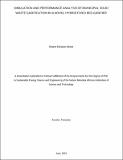| dc.description.abstract | Municipal Solid Waste (MSW) is a main challenge to municipalities in developing countries due to
the increase in its production caused by technology development, community culture, population
growth, and urbanization. The challenge is heightened by the scarcity of dumping sites within
municipalities and the environmental impact associated with improper disposal management.
Thermo-chemical conversion technologies (gasification, pyrolysis and incineration) have become
to be known as practicable technologies for municipal solid waste management (MSWM). In this
study, the Hybrid Fixed Bed Gasifier (HFBG) model was developed using Aspen Plus in order to
merge the advantages of both downdraft and cross draft gasifiers and suppress their disadvantages.
Furthermore, experimental analysis of the flue gas was carried out on the HFBG. The TESTO 327-
1 flue gas analyzer was used to analyze the concentration of CO, CO2 and O2. The simulated results
showed that the feedstock MC of about 59.8 wt% was lowered to 6.8 wt%. The developed hybrid
fixed bed gasifier demonstrated an increase in
2
H
and
CO
of about 29.29 % and 37.05 % mole
fraction in the producer gas respectively. The syngas output was highly affected by the changes in
the ER as well as change in temperature. The composition for
2
H
and
CO
increases with increase
in temperature while the composition decreases with ER between 0.1 to 0.4. However, at this ER
CO2
and
H O2
tend to increases but above 0.4
CO2
and
H O2
decrease gradually. Experimental
results show that after the elapse of 30 minutes CO and CO2 concentration was 9.69% and 5.85%
respectively. Furthermore, after 150 minutes of the gasification process, the output concentration
for O2 was 17.2 % while the concentration for CO and CO2 was 0.0 % and 3.77 % respectively. The
experimental results revealed that, during the entire gasification process the concentration for CO
and CO2 were decreasing with time while O2 concentration was increasing. This result shows
diversion from the simulated results due to gasifier leakages. With high MC of MSW, the study has
shown that, HFBG can handle up 60 wt% as compared to downdraft which is limited to 20 wt%. | en_US |

